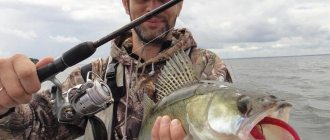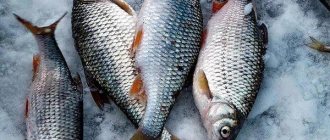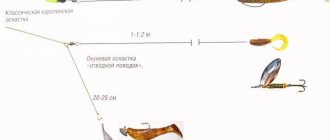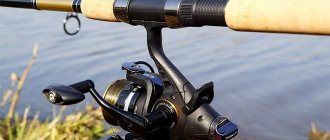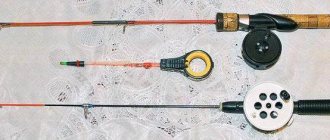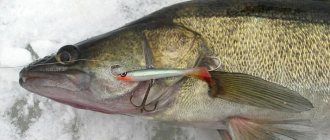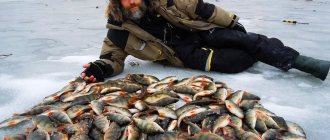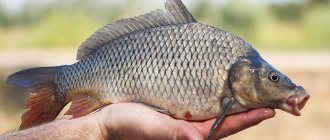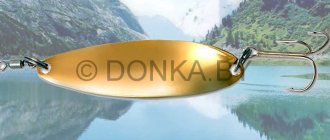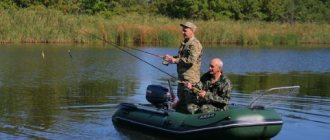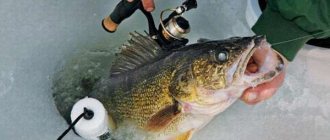When does pike perch start biting in the spring?
In March, in the interval between the melting of the ice and the beginning of the flood, pike perch can feed both in relatively shallow water and in deep areas of the reservoir, in the water column or at the bottom. It's not easy to catch him at this time.
High water
During the spring flood, the pike perch bite stops almost completely. Against the backdrop of a rapid rise in water levels, hunting trips of this fish occur sporadically or stop altogether.
A good bite for pike perch becomes active after the peak of the flood has passed. At this time, the water becomes clear and its level begins to fall. This is the most successful time to start spring hunting for pike perch with a spinning rod.
The spring run of pike perch, during which the fish, following certain routes (paths), moves along the river to spawning grounds, takes place in the middle zone at the end of March - beginning of April. Fishing at this time will be very successful, the main thing is not to miss the moment of the beginning of the spring migration of pike perch and know where the trails are.
Spawning
The pre-spawning feast of pike perch begins after the peak of the flood, when the rivers have already returned to the banks, at a water level 2 - 3 meters above the summer level. Usually the zhor begins in the first half of April, it lasts 1 - 2 weeks.
Upon completion of spawning, a short-term post-spawning meal of pike perch takes place. Then this fish is caught quite well until the very end of spring.
Gear selection
Rod
The optimal size of a rod for fishing from a boat is 2.1 - 2.4 m, for shore fishing - 2.4 - 2.7 m. The blank should be sensitive enough to make it convenient to work with the main type of bait for pike perch - jig baits, and powerful enough to withstand working with pike perch baits in the current.
We recommend that you pay attention to such models as:
- Maximus Dreamer - 9 feet long, with a cast of up to 35 grams: a rod for jig fishing for pike perch both from the shore and from a boat.
- Nautilus Magnet - 8 feet, 21 grams: good for fishing with wobblers and light jigs, at depths of up to five meters and in relatively light currents.
- Extreme Fishing Panache - 7.4 feet, 18 gram test: All-rounder. Suitable for fishing in any conditions where baits (jigs, wobblers, spinners) that fall within the specified test range work well.
Coil
To hunt for pike perch with a spinning rod, you can use a spinning or multiplier reel.
A spinning reel is a more versatile, easier to use and popular option.
Experienced fishermen often prefer:
- Okuma RTX-35 is a high-quality reel that has good traction characteristics and lays the line well. Size 35 according to Okuma classification will be optimal for walleye fishing in most cases, but you can take a larger or smaller reel.
- Okuma CeymarC-35 FD - like RTX, it has good traction characteristics and high quality line laying. Instead of 35, you can use size 30 or 40 according to the Okuma classification.
fishing line
For pike perch in the spring, it is better to use a braided fishing line on a spinning rod, which is practically not subject to stretching. In spring, in cold water, the fish are still quite passive, and you can take a thinner line for fishing.
For hunting pike perch weighing up to two to two and a half kilograms, braid with a diameter of 0.12 to 0.14 mm will be quite sufficient.
When fishing in snags or in any other places where snags often occur, you can take a thicker braided line. This will lead to a decrease in casting range, but will allow you to tear the bait out of the hooks.
Leash
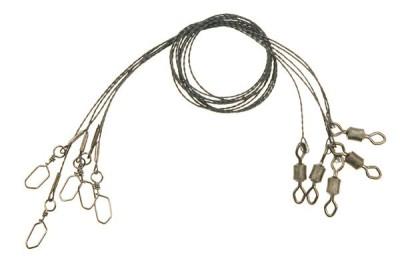
True, when catching pike perch with a spinning rod, you often catch pike. If you are going to fish in places where there is a lot of fish and the probability of being bitten is high, it is still better to put a leash. You can purchase a ready-made metal leash in a store or make it yourself.
Most ready-made leashes that can be found in stores are not of high quality: their fasteners unbend, swivels break, and the leash material itself quickly loses its shape, which prevents good wiring. Therefore, many people prefer to make their own leashes from guitar strings.
What to catch
Various equipment is used to catch pike perch, with the only exception being fly fishing. Otherwise, it can be either a donka for live bait or a float-based live bait tackle. Unfortunately, in the spring there is little time for bottom tackle, because pike perch feed from the bottom for only a few hours.
The float is also not effective; walking along the dirty shore with bulky gear is not very convenient. In addition, in order to achieve a bite, the bait must be held for some time, which is almost impossible to do with live bait.
In this article we will look at spinning fishing. This tackle allows you to move freely along the shore, change the behavior of the bait, and also make the necessary delays in the right place.
Since pike perch is caught using a jig, the rod should transfer all the irregularities of the bottom directly to the hand. Only fast and ultra-fast action forms can boast of such characteristics. The length should be selected depending on the size of the reservoir and coastal vegetation.
The rod test depends on the baits used, and the weight of the bait, in turn, is selected depending on the casting distance and the size of the twister. A rod of 2.7 meters, fast action, with a weight of 10 grams or more can be considered a universal tackle .
The reel, as always, should be in harmony with the rod. The spool size can be 2500, although there is no difference. The main thing is that the reel holds enough line for long casting, because the treasured stone or snag may be far from the shore.
The location of the clutch does not matter much. Pike perch are not aggressive when fishing, so additional brake adjustment may not be necessary.
as fishing line . Unlike monofilament, braid has no stretch and conveys an accurate picture of the state of the bottom. Only silicone baits The pike perch first hits the bait with its muzzle and then tries to eat it. By hitting a hard bait, it will most likely alert him, and he will lose interest in it.
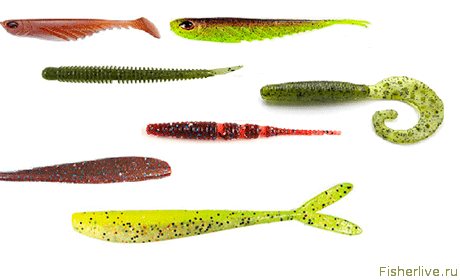
Lures for spring fishing
Typically used for catching pike perch:
- jig baits;
- wobblers;
- rotating and oscillating spoons.
Each of these types of baits can produce excellent walleye catches. The main thing is to know in what conditions you should use this or that bait and master the technique of placing it. We suggest taking a closer look at each bait.
Jig lures
Jig fishing is one of the most effective options for catching pike perch. This method works well in the spring. The most catchy jig baits for pike perch are:
- vibrotails;
- twisters;
- foam fish.
The bait can be mounted on a jig head or on an offset hook with a bullet weight (for fishing in places where there is a high probability of getting caught).
Wobblers
Wobblers are good because they can be cast far and can be easily retrieved at any speed, even the slowest. They are suitable for fishing at medium and shallow depths.
Crank wobblers with a large shovel show good results when catching pike perch. Such a wobbler is least susceptible to snags, since when it encounters an obstacle it simply “tumbles” over it.
Spoons
Rotating and oscillating spoons can be used in areas with shallow depths (oscillators - up to 5 m, spinners - 2 - 3 m) or when fishing in the water column.
The best oscillating spoons for pike perch are long and narrow, about 5 - 7 cm long.
Rotating spoons are front-loaded. It is worth noting that the main pike perch baits are jig baits and wobblers.
Choosing a biting spot
Where do small pike perch feed in the spring?
Small pike perch should be looked for in places where fry accumulate, which is its main food. In the spring, when the ice on reservoirs begins to melt and areas of clean water (edges) appear along the shores, small items rush to these well-warmed points by the sun. Here you can also hunt for zander in March with a spinning rod.
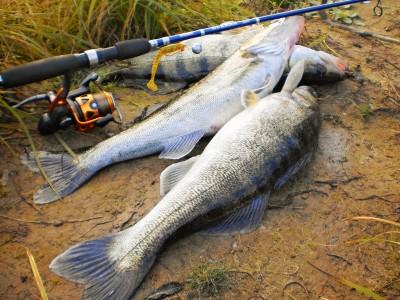
- eyebrows;
- snags, trees fallen into the water;
- uchatsky with reverse flow or the boundary of the “return” and the main flow;
- mouths of streams and small rivers;
- thickets of grass that begin to grow in late April - early May.
What places does large pike perch like?
But large pike perch in the spring, as at any other time, should be looked for at depth. It rarely appears in the coastal zone. This fish is attracted to various irregularities in the bottom topography. Promising points for hunting pike perch with a spinning rod may be:
- edges and boundaries of pits;
- trees, snags, boulders lying on the bottom;
- small hills located at the bottom with a diameter of about 2 - 3 or more meters.
Spawning run
During the pre-spawning run, pike perch moves from their winter resting places to the spawning grounds. At the same time, it can move along the channel, along the edges or along the border of the main flow and the reverse flow, lingering in areas with anomalies in the bottom topography - on the same edges, at the dumps of pits and at other similar points.
Where to catch pike perch using a spinning rod in March
March is the very month when pike perch is caught both from the ice with winter gear and from open water with a spinning rod. In the same region, some reservoirs are free of ice, and somewhere else you can go ice fishing for a whole month - this difference depends on the presence of currents in the reservoir, the salinity of the water in sea bays and many other reasons. Today’s story is about fishing for pike perch using a spinning rod in March in open water.
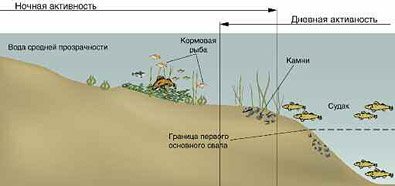
At the beginning of March, pike perch are searched for near the wintering pits, because, although at this time they are already starting to flock together in preparation for spawning, they do not yet go far from the places where they spent the winter. The fanged predator rarely goes into shallow water at the beginning of the month. Schools of pike perch stay at depths from 5 to 15 meters.
Little by little, the water warms up in March, and the fanged fish begins to move more - it can be found near the places where rivers and streams flow into the main body of water. In such places, the water column is most saturated with oxygen, so all the young fish, yearning for fresh water over the winter, rush here. Pike perch and other predators, in turn, come here to hunt for the fry.
This is interesting: Fish biting calendar
At the end of March, the water in lakes and rivers is already noticeably warmed up, and the pike perch begins to move throughout the reservoir, gradually approaching the places of future spawning. At this time, pike perch begins to have a pre-spawning feast, and you can catch a lot of it with all types of gear, including spinning.
Factors that influence the early spring bite
When fishing for pike perch in early spring, spinning is influenced by several factors:
- water level and its transparency;
- weather;
- Atmosphere pressure.
In the spring, due to floods or during heavy rains, the water level often rises rapidly and becomes cloudy. The activity of pike perch during sharp fluctuations in water level decreases significantly, and often the bite stops completely.
Also, you can’t count on pike perch bites when the water transparency drops below 15 cm. Good fishing results can be expected with a transparency of at least 30 cm.
In a situation of sudden change in weather, when a squally wind begins and the sky quickly becomes cloudy, the pike perch lies to the bottom and stops feeding.
As for pressure, the best pike perch bite can be expected if it is slowly increased over several days. In such a situation, the water is well saturated with oxygen, and small fish are activated, followed by pike perch. On the contrary, if the pressure drops rapidly, you cannot expect a good bite from the pike perch.
Factors influencing the activity of pike perch
When going to catch pike perch in the spring, it is important to know that the activity of the predator will depend on the following factors:
- Atmosphere pressure; - weather; — transparency and water level.
Note that a sharp change in the water level causes it to become cloudy; in such conditions, the activity of pike perch is reduced to zero. If the water transparency drops below 15 cm, you should not count on a good catch either. But with transparency above 25 cm, the activity of pike perch will be good and, provided that you can choose the right place, you can count on catching several trophies of decent weight.
Walleye activity will always be high if barometric pressure remains stable or increases slowly. When atmospheric pressure drops, the bite worsens or stops altogether.

Tactics and fishing methods
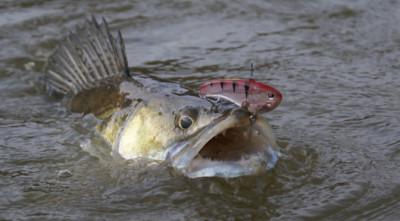
Therefore, in the spring it is especially important not to stand in one place, but to actively move, fishing as many edges, holes and “returns” as possible. If there are no bites at some promising point, you should not linger on it for long. It is better to fish this area, try several baits and wiring options, and then move on.
For fishing areas with a depth of 5 m , both in still water and in currents, a jig is best suited. Wobblers work well at depths from 1 m to 3 m Spoons can be used when fishing at a depth of up to five meters.
Fishing from the shore
Fishing from the banks, which in the spring are not yet covered with dense coastal and underwater vegetation, is quite convenient. Problems with free access to water may arise due to flooding of rivers and lakes, but you can find areas suitable for shore fishing on any body of water.
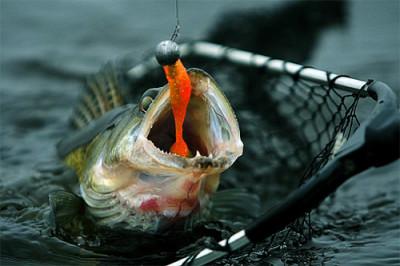
In spring high water, when rivers and lakes overflow their banks, throwing bait to the desired point with a short rod can be very difficult.
When fishing on the shore, promising points with sharp changes in depth, which should be given attention first, can be found by tapping the bottom with a jig. Also, interesting areas are determined by the nature of the current: in those places where there are any uneven bottom topography attractive to pike perch, swirls and other anomalies are visible on the surface of the water.
Fishing from a boat
Using a boat greatly expands the fisherman's capabilities. In this case, promising points with sharp changes in depth are quickly found using an echo sounder. If it is not there, you can navigate the reservoir in the same way as during shore fishing - using jigs and the nature of the surface current.
It should be remembered that in the spring on many reservoirs there is a ban on fishing with motors or a complete ban on fishing from boats.
These restrictions are set separately for each region.
Fishing technique
- Jig fishing technique. In the spring, standard jig fishing is used: after casting, you need to let the bait fall to the bottom, then make 2 - 3 turns of the reel handle, wait until the bait falls again and make another 2 - 3 turns. When there is little fish activity in the spring, it makes sense to take long pauses while lowering the bait.
- Fishing with wobblers. Some wobblers require simple uniform wiring. But most of them are designed for jerk wiring (twitching). In this case, a sharp swing of the rod is made, during which the bait makes a jerk forward, and the slack in the fishing line is immediately reeled in, then the next jerk is made.
The sharpness and frequency of twitching are selected separately for each wobbler, taking into account the activity of the predator. When fishing for spring pike perch, which are passive in cold water, it usually makes sense to use a fairly soft jerk retrieve.
- Spinner fishing technique. Spoons can be cast evenly in the water column. This option will work well for pike perch, which hunt in the middle layers of water - in the spring there is a chance of encountering such fish. Oscillating spoons can be held at the bottom with a regular jig step.
The places where pike perch stop and hunt in the spring can differ significantly from the usual summer spots, but if you choose the right moment for fishing and still manage to find active fish, success is guaranteed. A good spring pike perch is an excellent trophy for every spinner, and the ability to catch pike perch in the spring is an indicator of a certain level of fishing skill.
Tackle for catching pike perch in open water
Pike perch lives at depth most of the time and feeds in the bottom layer of water. This behavioral feature should be taken into account when equipping gear for pike perch. After the freeze-up and throughout the entire period of open water, the following gear is used:
- Spinning;
- Feeder;
- Float rod;
- Mugs and summer girders.
Spinning for zander
When choosing a spinning rod, you need to take into account the conditions of the upcoming fishing. Models with fast or extra-fast action are suitable. With such a rod it is easier to pierce the strong jaw of a predator.
The reel is used when fishing for fish. To catch large specimens, powerful and high-quality models are installed. When choosing a spinning reel, you should pay attention to the presence of a friction clutch. A resisting pike perch on a hook can make sharp jerks. A correctly adjusted clutch releases part of the fishing line without weakening its tension.
Particular attention is paid to equipment. It is better to use a spinning cord with a load capacity of at least 10 kg. To reduce the likelihood of snagging, it is advisable to use a Tyrolean stick or Carolina rig. The weight of the equipment with bait should be within the test rod limits.
Feeder for zander
If zander trails are known, then feeder fishing is applicable. The main elements of the tackle (rod, reel, cord or fishing line) are selected in the same way as for a spinning rod. But how to equip the feeder is up to each angler to decide at his own discretion. By the way, you can do without a feeder. But it is preferable to use a feeder. A bream that happens to bite along the way won’t be a big disappointment. Large feeder feeders with large cells are used.
Bait for pike perch is prepared from chopped fresh fish or sprat. You can use waste from fish processing before cooking. You can attract pike perch with crushed beef liver or condensed blood. The required viscosity is achieved by adding bran, breadcrumbs or fishing glue. Massive washing out of the bait should begin after the feeder is lowered to the bottom.
